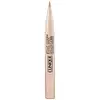What's inside
What's inside
 Key Ingredients
Key Ingredients

 Benefits
Benefits

 Concerns
Concerns

 Ingredients Side-by-side
Ingredients Side-by-side

Water
Skin ConditioningPhenyl Trimethicone
Skin ConditioningCyclopentasiloxane
EmollientIsododecane
EmollientPropylene Glycol
HumectantCyclohexasiloxane
EmollientCetyl PEG/PPG-10/1 Dimethicone
EmulsifyingGlycerin
HumectantButylene Glycol
HumectantTribehenin
EmollientTrimethylsiloxysilicate
EmollientDisteardimonium Hectorite
StabilisingPhenoxyethanol
PreservativePolyglyceryl-4 Isostearate
EmulsifyingHexyl Laurate
EmollientPanthenol
Skin ConditioningTriethoxycaprylylsilane
Alcohol
AntimicrobialSilica Dimethyl Silylate
EmollientCaprylyl Glycol
EmollientTalc
AbrasiveEthylhexylglycerin
Skin ConditioningDisodium EDTA
Tocopherol
AntioxidantCI 77891
Cosmetic ColorantIron Oxides
Water, Phenyl Trimethicone, Cyclopentasiloxane, Isododecane, Propylene Glycol, Cyclohexasiloxane, Cetyl PEG/PPG-10/1 Dimethicone, Glycerin, Butylene Glycol, Tribehenin, Trimethylsiloxysilicate, Disteardimonium Hectorite, Phenoxyethanol, Polyglyceryl-4 Isostearate, Hexyl Laurate, Panthenol, Triethoxycaprylylsilane, Alcohol, Silica Dimethyl Silylate, Caprylyl Glycol, Talc, Ethylhexylglycerin, Disodium EDTA, Tocopherol, CI 77891, Iron Oxides
Dimethicone
EmollientWater
Skin ConditioningIsopentyldiol
HumectantPolymethylsilsesquioxane
Trisiloxane
Skin ConditioningMethyl Trimethicone
Skin ConditioningPentaerythrityl Tetraethylhexanoate
EmollientPhenyl Trimethicone
Skin ConditioningTribehenin
EmollientPEG-10 Dimethicone
Skin ConditioningHydrogenated Polyisobutene
EmollientSilica
AbrasiveLecithin
EmollientPolysilicone-11
Lauryl PEG-9 Polydimethylsiloxyethyl Dimethicone
Skin ConditioningCaffeine
Skin ConditioningDimethicone/PEG-10/15 Crosspolymer
Dimethicone/Vinyl Dimethicone Crosspolymer
Skin ConditioningPropylene Carbonate
SolventTriethoxycaprylylsilane
Alumina
AbrasiveTriethyl Citrate
MaskingSodium Chloride
MaskingDisteardimonium Hectorite
StabilisingLaureth-7
EmulsifyingSodium Hyaluronate
HumectantDipropylene Glycol
HumectantSodium Dehydroacetate
PreservativeDisodium EDTA
Phenoxyethanol
PreservativeCI 77891
Cosmetic ColorantCI 77491
Cosmetic ColorantCI 77492
Cosmetic ColorantCI 77499
Cosmetic ColorantCI 77163
Cosmetic ColorantMica
Cosmetic ColorantDimethicone, Water, Isopentyldiol, Polymethylsilsesquioxane, Trisiloxane, Methyl Trimethicone, Pentaerythrityl Tetraethylhexanoate, Phenyl Trimethicone, Tribehenin, PEG-10 Dimethicone, Hydrogenated Polyisobutene, Silica, Lecithin, Polysilicone-11, Lauryl PEG-9 Polydimethylsiloxyethyl Dimethicone, Caffeine, Dimethicone/PEG-10/15 Crosspolymer, Dimethicone/Vinyl Dimethicone Crosspolymer, Propylene Carbonate, Triethoxycaprylylsilane, Alumina, Triethyl Citrate, Sodium Chloride, Disteardimonium Hectorite, Laureth-7, Sodium Hyaluronate, Dipropylene Glycol, Sodium Dehydroacetate, Disodium EDTA, Phenoxyethanol, CI 77891, CI 77491, CI 77492, CI 77499, CI 77163, Mica
 Reviews
Reviews

Ingredients Explained
These ingredients are found in both products.
Ingredients higher up in an ingredient list are typically present in a larger amount.
Ci 77891 is a white pigment from Titanium dioxide. It is naturally found in minerals such as rutile and ilmenite.
It's main function is to add a white color to cosmetics. It can also be mixed with other colors to create different shades.
Ci 77891 is commonly found in sunscreens due to its ability to block UV rays.
Learn more about CI 77891Disodium EDTA plays a role in making products more stable by aiding other preservatives.
It is a chelating agent, meaning it neutralizes metal ions that may be found in a product.
Disodium EDTA is a salt of edetic acid and is found to be safe in cosmetic ingredients.
Learn more about Disodium EDTADisteardimonium Hectorite comes from the clay mineral named hectorite. It is used to add thickness to a product.
It can also help stabilize a product by helping to disperse other ingredients.
Hectorite is a rare, white clay mineral.
Learn more about Disteardimonium HectoritePhenoxyethanol is a preservative that has germicide, antimicrobial, and aromatic properties. Studies show that phenoxyethanol can prevent microbial growth. By itself, it has a scent that is similar to that of a rose.
It's often used in formulations along with Caprylyl Glycol to preserve the shelf life of products.
Phenyl Trimethicone is a silicon-based polymer. It is derived from silica.
Phenyl Trimethicone is used as an emollient and prevents products from foaming.
As an emollient, it helps trap moisture in the skin. It is considered an occlusive.
Learn more about Phenyl TrimethiconeTribehenin comes from glycerin and behenic acid.
It is used as an emollient, or moisturizer. Emollients form a thin barrier on skin to prevent moisture from escaping.
This ingredient may not be Malassezia folliculitis, or fungal-acne safe.
Learn more about TribeheninTriethoxycaprylylsilane is a silicone used to bind and stabilize ingredients.
As an emulsifier, it helps prevent ingredients from separating. This can help elongate the shelf life of products.
Triethoxycaprylylsilane is often used to coat mineral sunscreens ingredients to help give a better feel. It also helps reduce oxidative stress in sunscreens.
Learn more about TriethoxycaprylylsilaneWater. It's the most common cosmetic ingredient of all. You'll usually see it at the top of ingredient lists, meaning that it makes up the largest part of the product.
So why is it so popular? Water most often acts as a solvent - this means that it helps dissolve other ingredients into the formulation.
You'll also recognize water as that liquid we all need to stay alive. If you see this, drink a glass of water. Stay hydrated!
Learn more about Water